Greening the Government: Sustainable Building Solutions for New Public Programs
Renovation. An order of magnitude greater, renovations tend toward big-ticket projects addressing multiple building systems and materials at once and significantly affecting operations and performance. These projects may include structural changes, enclosure assemblies, MEP plant additions and extensive finish material changes. They can also simply address a tenant installation (TI) project, which is the focus of the U.S. Green Building Council's LEED for Commercial Interiors (LEED-CI) program; in this case, a property's overall operations may not be materially improved, but a single occupant zone is made substantially greener.
Green building renovations are becoming "the new normal," according to SBI Energy, largely due to rising energy costs. "The majority of the world's buildings are old and waste energy. We anticipate the building industry will see a significant increase in green building renovation to make structures more energy efficient, particularly since these types of retrofits pay for themselves after only a few years," said Bernie Galing, an SBI analyst who authored the recent report,Global Green Building Materials and Construction, 2nd Edition.
New construction. Larger renovation projects may be so extensive as to be considered new construction, according to the USGBC. LEED for New Construction (LEED-NC) includes "major renovations," which the group views with the potential to create high-performance commercial and institutional projects. Additions, expansions and other extensive facility changes should be treated as new construction projects in terms of sustainability.
Building operations and maintenance (O&M). The USGBC's LEED for Existing Buildings: Operations & Maintenance (LEED-EBOM) was introduced as a pilot in 2002 and served as a formal codification of a long held belief: That even the greenest building designs could be subverted by poor O&M. LEED-EBOM provides a benchmark for building owners and operators to compare their practices in whole-building cleaning and chemical agents, recycling, exterior maintenance, and systems upgrades. LEED-EBOM is just one way to ensure O&M practices are best-in-class, but building design and construction professionals need to be aware of this system as it has been adopted by countless municipalities and agencies.
Greening through Product Replacement
The idea of product replacement as a strategy for greening government buildings runs counter to a few common preconceptions about sustainability, including the focus on source reduction, life-cycle impact and durability. One's intuition says it's greener to use what we already have − yet in practice, the opposite may be true.
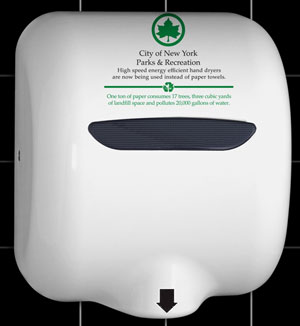 |
Newly installed hand dryers in New York City's Department of Parks and Recreation have reduced energy needs by 80 percent and cut down on paper waste. Photo: Excel Dryer, Inc. |
This conclusion occurred to New York City's Department of Parks and Recreation, which has adopted green building practices through a citywide initiative called PlaNYC, which includes building green roofs, purchasing more fuel-efficient vehicles, and pursuing alternative energy projects. Recent work in Central Park and other area public restrooms included the replacement of existing paper towel dispensers and old electric hand dryers with high-speed dryers bearing the parks department logo. The benefits, according to parks officials, include paper waste reduction and about 80 percent reduced electricity needs because the dryers take only 10 seconds or so per visitor.
"Life-cycle assessment studies show a reduction of up to 70 percent in the hand-drying carbon footprint," says Bill Gagnon of Excel Dryer, Inc., East Longmeadow, MA, a company now working with the DOE's Federal Energy Management Program (FEMP) to establish a category for high-efficiency hand dryers. "A single facility can use millions of paper towels each year - it's amazing how much trash can accumulate - and government agencies says that's where they can make the biggest impact."
Beyond one-to-one appliance replacements, product add-ons also offer a low-cost, low-impact way for government owners to address underperforming existing components or systems. Examples include power monitors, occupancy sensors or timers for automatic shut-off of lighting and computers, a strategy used by the Internal Revenue Service at its new, LEED-rated St. Louis facility. According to Joseph R. Campfield, IRS director of building operations, the seasonal nature of the facility and resulting flux in staffing levels made it essential to use motion sensors not only to save energy, but also to allow for reconfiguring of ambient lighting in affected office areas. This is accomplished by adjusting how the sensors are connected within overhead fixtures.
While green buildings depend on products to last as long as possible − ideally for reuse after they are removed, too − clearly governments can get greener in some cases by replacing existing underperforming assets.
Green Retrofits
Simply put, retrofits add new technology to older systems. Considering that government projects will rarely start from scratch - even new construction will often have to conform to older, "grandfathered" codes and policies -retrofitting will often be the simplest approach to greening. Additionally, a thoroughly developed retrofit strategy will save energy and construction costs associated with full renovation or with new construction.
Retrofits may come with a hefty price tag, too. But the result can be high impact, achieving cost benefits as well as potential health and environmental benefits. In a 2008 survey on green retrofits by Deloitte and Touche, 75 percent of respondents in the commercial sector who had implemented green retrofits said they were "very satisfied," while the remaining portion said they were "somewhat satisfied." About 63 percent of respondents said that they had spent at least 5 percent more than they would have on conventional − that is, non-green − retrofits. About 83 percent said that they were "very likely" to implement further green retrofits in the future, although their motivations to do so varied widely.
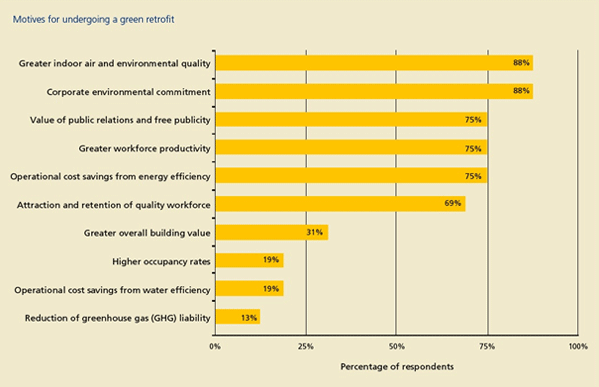 |
|
Among reasons to undertake a green retrofit project, indoor air quality is a leader, according to a survey by Deloitte & Touche. Source: Deloitte & Touche |
Almost any building system can be retrofitted to be greener and better performing, including HVAC, facade systems, roof systems, fenestration and glazing. The original 1950s brick façade of the Dover Air Force Base Medical Group building in northeast Delaware, for example, had been suffering from a poor design without weepholes. Moisture accumulated behind the masonry, leading to spalling and pushing the brick exteriors outward.
To stabilize the envelope and make it more energy efficient, the project team replaced all windows and doors and then overclad about 60,000 square feet of leaky brick with an exterior insulation and finish system (EIFS) on top of a new spray-applied air barrier and waterproofing membrane. The resulting façades received a textured finish with self-cleaning properties to ease facility maintenance. "Wrapping the building with a lightweight product sealed it for moisture protection and gave us the flexibility of design that we needed," said Lyndon Brown, project leader for the architect, Davis Stokes Collaborative.
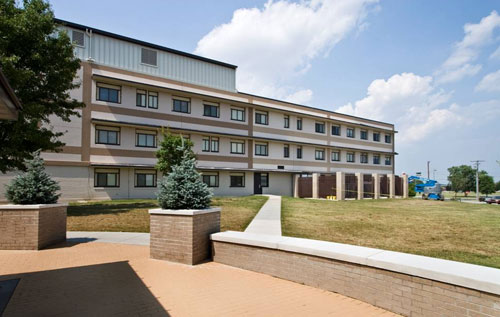 |
A brick building on the Dover Air Force Base was stabilized and made more energy efficient with an overcladding of an exterior insulation-and-finish system (EIFS). Photo: Sto Corp. |
Notice
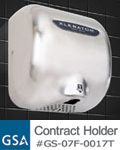
800-255-9235 | www.exceldryer.com
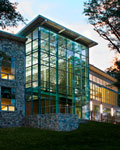
866-482-7374 | www.sunguardglass.com









